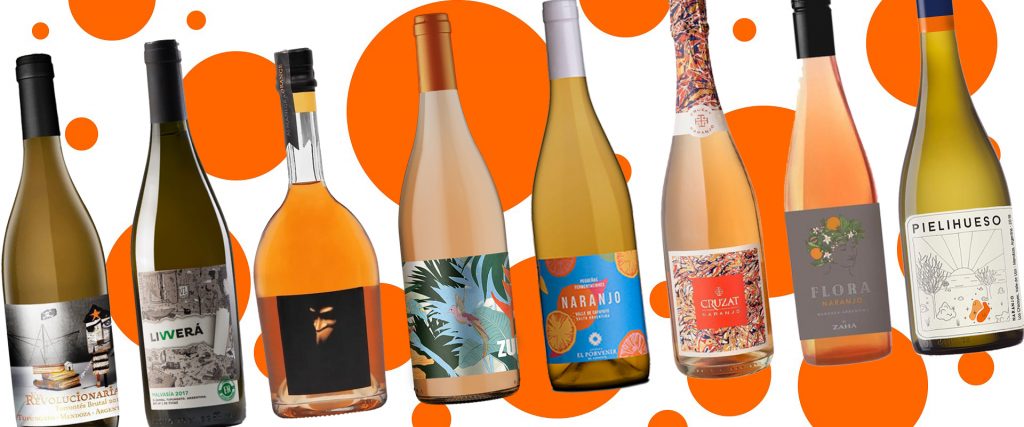The current generation of oenologists is exploring new horizons for Argentine wine. Some are carrying out in-depth studies of terroir, others trying out new styles and winemaking methods. The fifth largest producer in the world is pushing the envelope in every direction.
Winemakers have got used not only to exhaustive experimentation with different varieties, from Malbec to Garnacha, Cabernet Sauvignon to Monastrel, but also different production techniques. These include the development of orange wines in Argentina (wines made with white grapes fermented and macerated with skins) which has consolidated itself as a niche but solid trend.
Orange wines in Argentina
This new category in Argentine wines is breathing fresh life into the range of available styles. It’s just one of the benefits of the traditional freedom available to Argentine winemakers, who aren’t governed by the strictures of Denominations of Origin that exist in other latitudes.
‘Showing that Argentina is willing to try new styles of wine is important to the thousands of consumers looking to try exotic wines that offer something different to the classics, who now see us as an option. Argentina can make every different kind of wine you care to name and there’s a good market for that these days,’ says Cecilia Bonnet, the Argentine sommelier at the exclusive London wine club 67 Pall Mall.
The orange dawn in Argentina
In 2011 the first of the orange wines in Argentina was released: Vía Revolucionaría Torrontés Brutal 2011, by Matías Michelini. Even its maker admits that the primary motivation was more gastronomic than oenological: ‘Torrontés Brutal,’ he admits, ‘marked the beginning of my quest to find a wine that goes well with sweetbreads. I felt that whites lacked structure and the reds were too much, so I experimented with a white made from Torrontés fermented with skins and discovered a very interesting category for food pairings.’
It was a few years before his colleagues started to pay attention: only in 2016 did other labels join a movement that now numbers about thirty, available in Argentina and overseas. ‘The growth in gastronomic culture has helped these wines greatly and there’s plenty of room for further expansion,’ Michelini says enthusiastically. In addition to his own wines, he is also acting as a consultant in the area for several other wineries.
Orange power
Since then orange wines in Argentina have developed into an authentic new speciality. Although volumes are still low, the wines are being made in several different parts of the country from different grape varieties determined by the taste of individual oenologists.
Among the ‘classics’, if the term is appropriate for the phenomenon of white wines made as though they were reds, stand outs include: Domaine Alma Negra Orange, launched in 2016, followed by Livvera Malvasía by Germán Masera, Chardonnay 2km from Finca Beth and Bodega Pielihueso’s orange, the result of a co-fermentation of Torrontés, Sauvignon Blanc and Chardonnay.
While doubters of the orange movement might think that was plenty already, in 2019 about twenty new wines were launched to assuage both the curiosity of consumers and the needs of oenologists. Maricruz Antolín, who runs the biodynamic winery Krontiras, explains: ‘Our new orange wine makes use of a plot of Chardonnay from a warm area that wasn’t suitable for the style of fresh whites we were looking to make. So we harvested it very early and fermented it for seven months with skins. The result is a subtly expressive wine.’

Krontiras’ new wine has been joined by several other examples that promise much for adventurous drinkers: these include Flora Chardonnay Naranjo from Zaha, created by Alejandro Sejanovich; Porvenir de Cafayate Naranjo, made from Torrontés and Moscatel Rosado from a pergola vineyard first planted in Salta in 1945, Zun Zun Naranjo, made from Sauvignon Blanc by Lamadrid Wines; and, in the east of Mendoza, the oddity that is Moscatel Naranjo, made by Matías Morcos. The most exotic of them all, however, is that recently presented by the sparkling specialist Cruzat, a Pet Nat combination whose bubbles offer a whole new flavour experience.
Why orange?
Early on in this movement in Argentina, winemakers had to explain what it was they were doing exactly, and why. Because it was fermented like reds with stalks and skins, the wine came out a shade of orange and was often cloudy because producers preferred to leave them as natural as possible. They offer very intense palates with good texture and body for whites but floral aromas with penetrating white fruit or citrus notes depending on the grape varieties from which it was made.
Fortunately, they fit Argentine cuisine like a glove. Apart from the sweetbreads mentioned by Michelini when he set out to explore the style, they are also a good option to accompany empanadas, goat’s cheese, charcuterie and fatty cuts such as skirt steak and other specialities.



